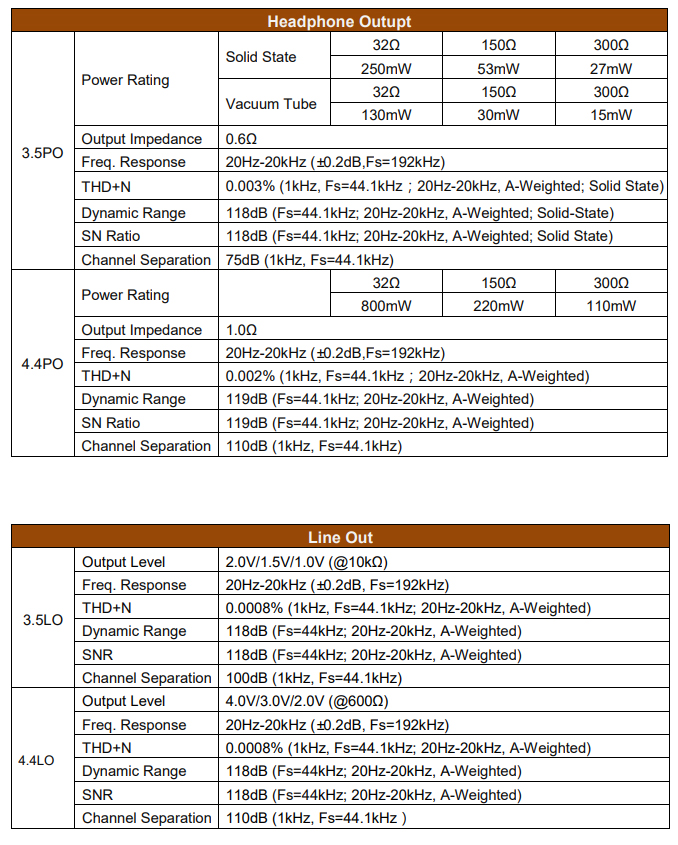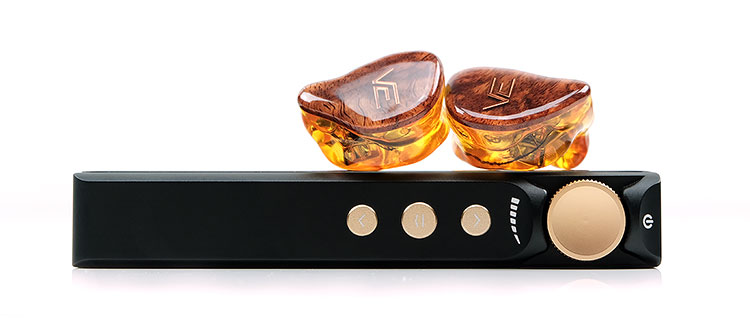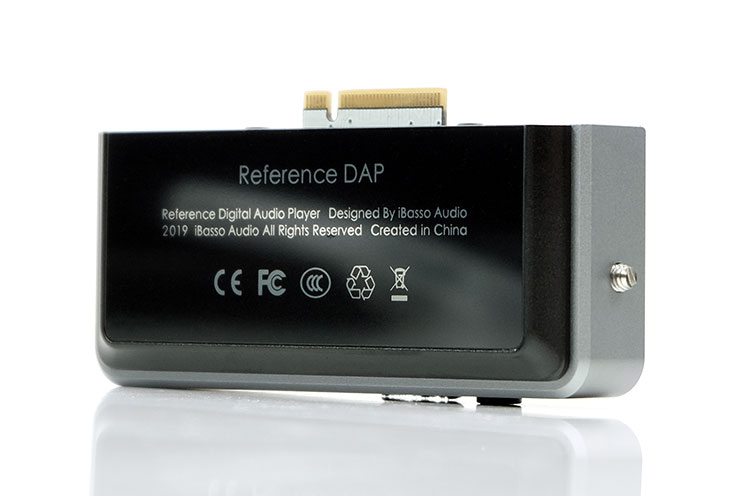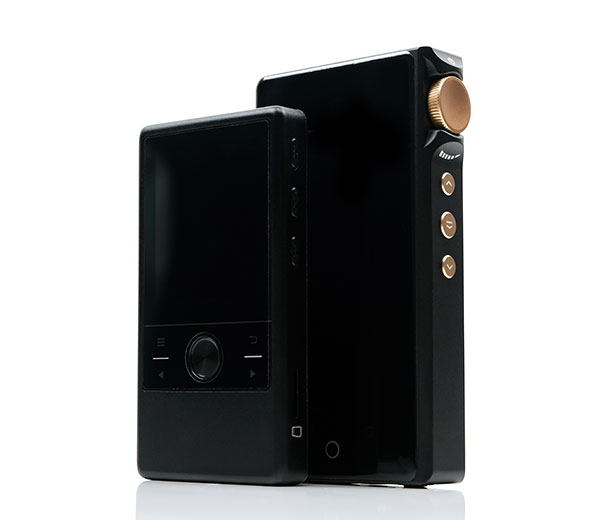N3Pro Synergy
Efficiency
With sensitive monitors, you are going to pick up a bit of hiss and more so with the tube operational mode than the solid-state 3.5mm alternative. The lower noise floor will be the solid-state 3.5mm output and the 4.4mm solid-state not far behind with the likes of the Campfire Audio Solaris in low-gain mode.
However, once you move up to medium efficiency monitors like Cayin’s own YB04, FiiO’s FA9, and the tia Trio the background hiss is non-existent for both solid-state outputs and only the faintest of hiss levels for the tube operational mode unbalanced. Anything below 110dB SPL should be safe for noise.
Channel balancing is very good for all operational modes but tube ringing is noticeable, especially on light taps during playback lasting for about 4-5 seconds and then fading away. Of course, no tube rings in solid-state mode.
Pairings
I thought the N3Pro to be a perfect pairing with clean-sounding monitors or those that placed vocals front and center.
Cayin YB04
Cayin’s own YB04 sounded like it was referenced in their production of the N3Pro with a beautiful timbre, not too soft or dry, just a sweet tone with the right level of density from its quad-BA configuration, particularly female vocal performance which were exquisitely euphonic but without sounding annoyingly rounded and dulled down at the same time.
I also thought the YB04 mids and treble performance did very well with the Ultra-linear tube mode with the Triode forcing me to up the volume. Something about the dynamic range there not quite as impressive as the Ultra-linear variant.
Going solid-state balanced added a bit more staging complexity to the YB04 performance and better channel separation but pulled back the vocal positioning a little in comparison to the Ultra-linear mode.
Gaudio Nair
The Gaudio Nair is a reference type monitor with a very linear low-end, good mids performance, and a coherent even treble tuning. It has an impeccable level of control and a little more neutral than the YB04.
Here I found the solid-state N3Pro pairing with the Nair to leave me a bit cold. It is precise, accurate but perhaps too controlled. Kind of like your everyday monitor performance that doesn’t really create a memorable feeling. If you want to stick with solid-state go balanced with the Nair for a superior level of instrumental separation and a bit more enjoyable low-end impact.
The Ultra-linear tube operational mode gives the Nair pairing a massive lift in character with vocals sounding fuller, further forward, and a lower-mids response that’s dripping in beautiful euphonic-infused texture. It’s more intimate but also more engaging in a similar way to the YB04 but perhaps with a bit more timbral body.
Noble Audio Zephyr
I also felt the solid-state balanced output of the N3Pro worked well with IEMs that need a bit of punch to their bass to lower-mids performance to get the balance just right.
For example, the Zephyr’s dynamic driver for the low-end felt a little soft and slow with the tube operational modes. However, with the solid-state balanced output, it sounded tighter and snappier in keeping with how I feel the Zephyr should sound.
Admittedly, the creamier vocal performance with the N3Pro Ultra-linear mode blends beautifully with the Zephyr’s pushed upper mids but it becomes almost too mid-centric with not enough bass depth.
Power Pairings
The closest mid-fi DAP for a full headphone’s performance to the N3Pro that I have reviewed is the HiBY R5 with its 564mW per channel into 32Ω balanced rating but even it does not have quite the dynamic range of the N3Pro’s 800mW output.
Using a Dan Clark Audio Ether 2 balanced will give you enough headroom, at least compared to the 800mW of the on-ear headphone setting of the FiiO M15. I do not think the N3Pro is as resolving as the M15 but in the high-gain mode, about 65 steps volume setting was more than enough to get the Ether 2 loud and fairly dynamic sounding.
The bigger drop to the 250mW 3.5mm unbalanced solid-state reduces channel separation and staging width and is best reserved for less demanding portable headphones and IEMs.
The Audeze LCDi4 is a good example of a specialized monitor that should have no issues working off either output but I preferred the 4.4mm output for the more expansive staging element which suits its expansive and open presentation.
The Audeze LCD-2 was also a very good pairing with the N3Pro going 4.4mm high gain. Now, before you sell off your dedicated desktop I would say that the sweet spot for me is around 1W or a good current amplification rating. For example, the Auris Audio HA-2SE single-ended 1W output at 50Ω did sound fuller and more expansive than the N3Pro balanced output.
However, the timbre of the N3Pro and relative dynamic range was excellent for a DAP at this price point. It did well with the uneven performance of the Audeze treble tuning and just enough weight on the lower-mids for guitars to sing with authority. There is also plenty of volume on high gain to get the LCD-2 to a very loud level.
Select Comparisons
(Comparisons were completed with Campfire Audio’s Ara, the Solaris SE, Andromeda 2020, Cayin’s YB04, Vision Ear’s VE4.2, and Nobel Audio’s Zephyr).
iBasso DX160
$399
Technical
The DX160 was launched in late 2019 with a solid review from us in Dec of that year. It is priced a little cheaper than the N3Pro at $399 and also goes in a very different direction in terms of user experience.
Both DAPs do have a dual delta-sigma DAC implementation though with different chipsets. The DX160 uses a dual Cirrus Logic CS43198 implementation whereas the N3Pro offers a dual AK4493EQ design.
Decoding for both is quite similar at up to native DSD256 and PCM 32BIT/384kHz but the DX160 right now covers MQA X4. The advantage is temporary as the N3Pro will have an MQA firmware update coming very soon.
It is always tricky to directly compare amplification power from these two companies as iBasso’s calculation via Vrms is not quite the same as Cayin’s loaded mW ratings. However, under a 300Ω load, the DX160 is capable of up to 34mW unbalanced and 136mW balanced compared to the N3Pro’s maximum 27mW unbalanced and 110mW balanced.
That does mean the DX160 can cope marginally better than the N3Pro for heavier loads but as we know amplification shaping for current on very light loads may well mean the Cayin can offer more headroom at the 32Ω level.
Of course, the major difference in terms of amplification is the use of tubes as well as resistor-based outputs for the N3Pro and the fixed solid-state output of the DX160 which is a departure from their DX200/220/150 amp card system.
Design
The DX160 is the slimmer or flatter of the two DAPs but slightly wider and marginally taller. Arguably the N3Pro is the more single-hand friendly of the two due to the narrower dimensions even though it’s about 20g heavier.
The DX160 has that beautiful 1080p screen dominating the design so its aesthetic is closer to a smartphone with Android 8.1 as opposed to the smaller IPS panel in the N3Pro and that touch-capable proprietary OS.
Both use rotary dials in combination with physical controls but the DX160 rotary version has no multi-function capability encouraging you to go with the touchscreen a lot more. The two DAPs have single micro-SD slots with the DX160 also offering 32GB of onboard memory.
Android does mean that the DX160 is much more expansive in terms of WiFi and app compatibility whereas the N3Pro is really set up to be a pure music player. Any expansion of the N3Pro will come via firmware updates. Both do have Bluetooth bi-directional support so they can interface with a smartphone in HiByLink or receive audio from another source if required.
Performance
Regardless of whether you slip into tube or solid-state mode with the N3Pro, the DX160 is going to sound the drier and cleaner of the two with a comparative peak in the upper mids and treble.
The DX160 is quite neutral, quite linear, and very expansive in terms of staging for a midrange player. That is the DX160 core strength, that ability to paint a complex presentation with plenty of air and separation with most monitors we tested.
In doing so, however, the timbre has much less of a euphonic tone and not as full-bodied or as liquid sounding as the N3Pro’s timbre in any operational mode. It does have a little bit of mid-bass warmth to prevent everything from being too cold sounding but overall it is much more linear in its delivery and not as weighted on the low-end.
Imaging in the mids is actually forward sounding for me on the DX160 for female vocals. Again, that uptick in upper mids presences does tease out a more immediate falsetto or soprano voicing, but also again, the DX160 shows plenty of comparative odd-harmonic presences that can seem edgy with the wrong pairing. Campfire’s Ara, in particular, was a fatiguing pairing with the DX160.
The N3Pro avoids that slightly hard-edged upper mids and smooths out the percussion attack a bit more in its solid-state mode. It doubles down on the euphonic overtone and liquid attack in both the tube modes which are noticeably warmer than the DX160’s response.
The Ultra-linear mode will also push a bit more sweetness and presence from the lower-mids but comparatively, relaxes the treble compared to the DX160’s more energetic top-end. The Triode mode drops the bass and lower-mids weight a little but sounds more intimate and narrower compared to the airy DX160.
Noise
The DX160 does have a lower noise floor with sensitive IEMs when compared to the N3Pro’s tube modes. In our tests with the Campfire Audio Ara, there was a bit more hiss in both the Ultra-linear and triode mode at low-volume.
The single-ended solid-state mode of the N3Pro is lower, especially with its 3-stage gain mode but still shows up a bit more hiss with both the Andromeda 2020 and the Ara compared to the DX160 single-ended.
I do give an advantage to the DX160 for its noise floor going balanced with sensitive IEMs. You will hear a lot more hiss on the N3Pro balanced output with the same tested IEMs. However, it does drop considerably with less efficient IEMs such as Cayin’s own YB04.
FiiO M11
$449.99
Design
The M11 is priced just slightly below the N3Pro but like the DX160 it is a vastly different user experience. For a start, it is much bigger and heavier compared to the N3Pro at 211g compared to 195g and 70.5mm x 130mm x 15.5mm compared to 63.5 x 115.2 x 18.9 (mm). The only aspect the N3Pro is larger is the height.
The M11 feels like a modern smartphone with that 5.15″ IPS panel compared to the 3.2″ IPS panel of the N3Pro. Both are touch-capable though but with Android 7 and the Samsung CPU, the M11 is very fast and powerful as well as being much more expansive.
The Cayin will feel the slower of the two though its more limited feature-set ensures its battery life is not too far behind at 9-11 hours compared to 13-15 on the M11. The M11’s Android setup can mean a lot more battery drain the more apps and features you use so this can and does dip more than the N3Pro battery life cycle would.
The M11 does have an advantage for memory also at 32GB onboard, OTG expansion-capable via USB-C as well as 2 microSD slots for external memory cards. The N3Pro can only offer 1 microSD slot plus OTG expansion and no onboard memory
Technical
Interestingly, both DAPs use a dual AK4493EQ implementation with similar decoding capability set at native DSD256 and PCM 32BT/394kHz. The one difference is the global MQA support recently added to the M11 which is due soon on the N3Pro. As yet I do not know the folding multiplication of Cayin’s new MQA implementation.
Both offer bi-directional Bluetooth though the N3Pro supports the newer BT5.0 protocol whereas the M11 is still stuck on 4.2. The two DAPs are capable of up to LDAC transmission, with aptX down to SBC also supported and within the FiiO app, you can also use HWA if your source or receiving device supports that.
In terms of amplification, the N3Pro has more grunt with a maximum of 800mW into 32Ω balanced and 250mW unbalanced using the solid-state mode. The M11 is good but slightly lower at 550mW into 32Ω balanced and 192mW unbalanced. The single state tube mode of the N3Pro is less powerful though at 130mW into a 32Ω load.
Both offer analog 4.4mm and 3.5mm PO outputs with the M11 offering an additional 2.5mm TRRS output. One major difference is the LO with the N3Pro offering a dedicated 3.5mm LO as well as s shared 4.4mm LO whereas the M11 only offered a shared 3.5mm LO.
Performance
In some ways, the tuning emphasis of these two DAPs are the polar opposite in terms of emphasis. I would not define the M11 as a particularly bright sounding DAP but it does have an airier more ethereal tone to the denser fuller sound of the N3Pro in its own solid-state mode.
The N3Pro fleshes out the low-end a bit more, adding some more sub-bass presence and punch with monitors such as the Zephyr from Noble Audio which just loves quality bass. The M11 is more linear in that regard but not cold sounding. There is a hint of warmth on the mid-bass that keeps it sweet in tone if not full in body.
The other key difference is the midrange. The M11 plays it very neutral so when you are witching back and forth you might find yourself adjusting the volume upwards to match the more intimate and immediate vocal delivery of the N3Pro.
Particularly when you switch to the Ultra-linear operational tube mode where mids get very engaging, lower-mids get fleshed out a bit more and vocals sound broad and big. In comparison, the M11 is airier and more spacious in the mids but stand-off’ish in comparison and does not engage quite as well.
Treble is the M11’s forte whereas the N3Pro is more relaxed opting for a more natural but smooth and relaxed performance. That is where the M11 gets its air and slightly brighter mid-range timbre from.
Staging
As a result, staging on the M11 opts for tall and airy whereas the N3Pro prefers to deliver something more intimate with the Triode mode, or mid-centric with the Ultra-linear mode. It can go deeper than the M11 in solid-state mode with a nice weight with punchier monitors such as the Vision Ears VE4.2 or the Gaudio Clariden.
I would opt for the likes of FiiO’s own FA7 or FA9 which are on the warm side for me and could do with that airier performance of the M11.
Noise
Both DAPs have a similar noise performance level in solid-state balanced though maybe it’s just me but the M11 hiss was at a higher pitch compared to the N3Pro white noise. In short, both will hiss with sensitive IEMs such as the Solaris SE.
The M11 noise floor is marginally lower going single-ended but the gaps are not that big. The bigger gap is when you switch to tubes where the N3Pro will throw back a higher noise floor and more hiss than the M11.
Here less sensitive IEMs might be required to even out the gap such as Cayin’s YB04 or Noble Audio’s Zephyr which was super quiet with the N3Pro’s tube operational modes.
iBasso AMP9
$249 (DX220 $899)
Positioning
For our 3rd comparison, I thought we would try something a little different with the iBasso AMP9 card rather than a full DAP comparison. A lot of DX200/220 users might be curious to see how their $249 tube card stacks up against the N3Pro at least in terms of power, noise, and sound quality.
Granted the DAC behind the card will have some influence and to that end, if you are thinking DX200/220 you have a dual ES9028PRO inside the DX220 with decoding up to DSD512 and PCM 32BIT/768kHz.
Overall, the DX220 DAC implementation delivers something more neutral in timbre but more expansive and resolving in terms of soundstage and dynamic range. Other AMP cards can color that impressively and the AMP9 is no different in that regard.
Technical
The AMP 9 can work on both setups and inside is current output implemented Korg Vacuum Nutube much like what you will find inside the N8.
The Korg is step up electrically over the dual Raytheon JAN6418 x 2 inside the N3Pro with a silicone shock absorber system to prevent pings that can happen when using the N3Pro.
It also has a lower 0.3Ω output impedance compared to 0.6Ω on the N3Pro and will run something like the DX220 down to about 6-7 hours max playback time which isn’t great compared to the 9 hours rated for the N3Pro tube output.
It is specifically designed for low impedance headgear with that current drive topology and offers a single 3.5mm PO which is the same as the N3Pro tube output though it lacks the dual operational mode switching capability.
Unfortunately, amplification specs on the AMP9 are thin on the ground with only a current power topology rating which is set at +/- 200 mA linear current output.
Performance
I have to be cautious here about making comparisons between the two amplification stages here because the DAC does play a role in the final coloration of the AMP9.
With the DX220 ES9028Pro implementation, the AMP9 still sounded quite smooth with a nice sweet euphonic tone but it is more neutral in weight and more expansive in its staging capability compared to the N3Pro’s tube operational stages. You get slightly more instrumental separation and headroom which, for me, is a signature of the ES9028Pro iBasso implementation.
The N3Pro’s Ultra-linear operational mode probably came closest to the DX220/AMP9 mids and treble sound using our test Cayin YB04 IEM and Campfire Audio’s Ara.
This operational mode has a wider staging sound than the alternative Triode mode and a little bit more of a sweeter tone to the timbre in keeping with the DX220/AMP9 emphasis. However, it still sounds the denser of the two with a broader vocal timbre and a bit more body in each note and perhaps not quite as resolving.
The Triode mode has a low-end closer to the DX220/AMP9 using the YB04 with a more neutral level of quantity and a slightly slower pace in comparison to the Ultra-linear modes more full-on bass and mids performance.
The AMP9 also sounds wider and airier compared to the Triode mode and a little bit pacier also, especially in the mids and treble where it extends a bit more. The Triode mode of the N3Pro sounds more intimate with a warmer vocal timbre due to a more relaxed treble presence.
Noise
The final note is noise. The AMP9 has a little short ring every time I fire it up which goes away after the first 1-2 seconds of music. I find that annoying, even with a medium efficient IEM such as the YB04 that doesn’t pick a huge amount of hiss from the AMP9.
With Ara, the AMP9 also has way too much hiss and pretty much unplayable with the AMP9 so I would not advise overly sensitive IEMs as a good pairing if you need a low noise floor.
The N3Pro can have the dreaded tube ring if you knock it but otherwise, its noise floor is lower than the AMP9 for the YB04. Whilst you will get hiss with the Ara it is also not as invasive as the AMP9.
Our Verdict
The N3Pro may well be Cayin’s cheapest DAP currently on offer but in no way is the N3Pro an entry-level media player. In fact, I would call it a bit of a bargain given what it can do and how it sounds.
For those that felt, (and still probably do), that the N8 is a flagship beyond their budget then the N3Pro can give you a slice of that dual operational mode and 4 different sounds for far less out of the wallet.
Importantly, in this sea of midrange DAPs, the N3Pro creates a unique proposition with that sweet and diverse dual-tube output. Granted, it is not an Android DAP and lacks the expansive OS features Android can bring to the table. That may well be a deal-breaker to some.
However, as a pure player, I do think it has more thought put into it than the competition with regards to how sounds and emotion can and should connect.
Is it perfect? Not as much as I would like with that small screen. However, the soon to be included MQA functionality is an important addition, something which the N6ii and the N8 already have.
Right now, I think Cayin’s media player roadmap looks incredibly consistent. The addition of the N3Pro only adds to that sense of natural-sounding identity and thankfully, at an affordable price point.
Cayin N3Pro Technical Specifications
Product Information
- DAC: AK4493EQ x 2
- MCU: XBurst 1.0GHz, MIPS-based
- Vacuum Tube: Raytheon JAN6418 x 2
- Storage: one TF card, up to 1TB
- Bluetooth: v5.0 (LDAC, UAT, AAC, SBC)
- Display: IPS 3.2” (480 x 360)
- Touch sensing: Capacitive touch screen
- USB: Type-C (Digital Audio, charging, OTG)
- Battery: 3.7V 4100mAh
- WiFi: IEEE802.11, 2.4GHz
- Dimension: 115.2 x 63.5 x18.9 (mm)
- Net Weight: 195g (±10g)
Battery and Duration
- Testing Condition: Screen off, all wireless disabled, mid-gain, volume 30, 32Ω earphone, playback 44.1kHz WAV music files
32Ω loading 3.5mm Single-ended solid-state: 11 hours - 32Ω loading 3.5mm Vacuum Tube Solid State: 9 hours
- 32Ω loading 4.4mm Balanced: 9 hours
- Charger Standard Charger (5V-2A): Charging Time ~3.5H
Digital Interface
USB Audio out
- Connector: USB-C
- PCM:up to 32Bit/768kHz
- DSD:Up to DSD512(Native), DSD256 (DoP), PCM 88.2kHz (D2P)
USB Audio DAC
- Connector:USB-C, Asynchronous USB Audio Class 2.0
- Support Windows(drivers required*), Mac OS, Android(partial)
- PCM: up to 32Bit/384kHz
- DSD: up to DSD256 (Native), DSD128 (DoP)
S/PDIF Coaxial
- Connector:USB-C(75Ω)
- PCM:up to 192kHz
- DSD:up to DSD64 (DoP)
Bluetooth
- Transmit Codec: UAT (up to 192kHz), LDAC (up to 96kHz),
- AAC (up to 48kHz), SBC (up to 48kHz)
- Receive Codec: UAT (up to 192kHz), LDAC (up to 96kHz),
- AAC (up to 48kHz), SBC (up to 48kHz)












